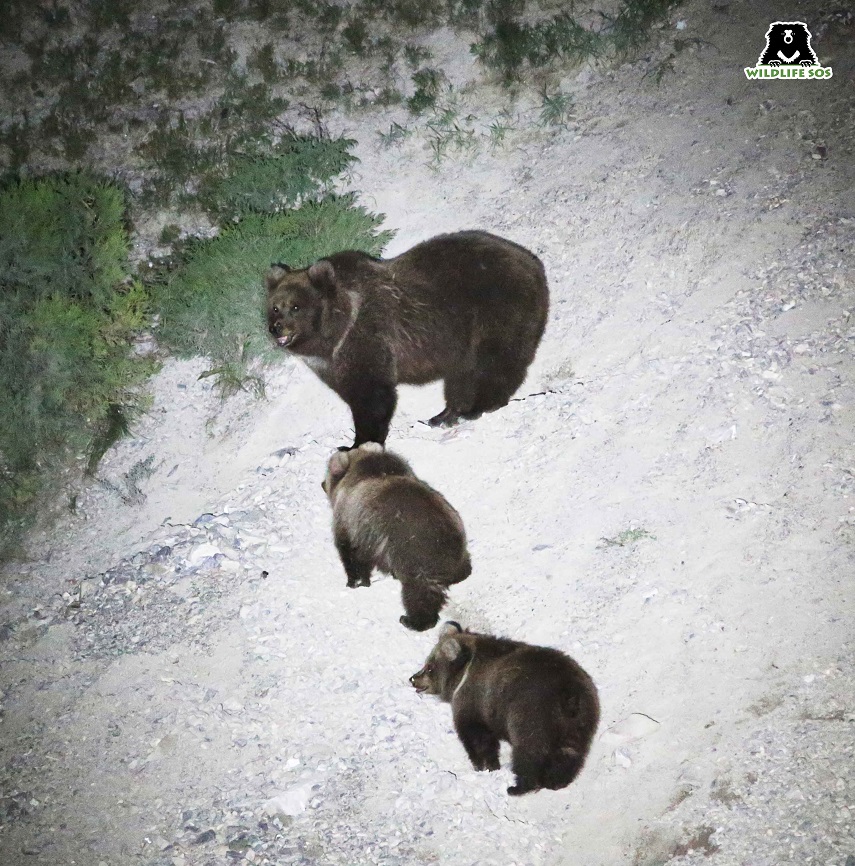
Srinagar- In a shocking revelation, the Jammu & Kashmir Wildlife Protection Department has found that 75% of food items consumed by Himalayan brown bears were scavenged from garbage, including plastic carry bags, milk powder, and chocolate wrappers, besides biryani.
The department has carried out an extensive survey on Himalayan Brown bear distribution and feeding patterns between the months of May and October 2021 along with Wildlife SOS—a non-profitable organization.
The official report titled “Himalayan Brown Bear Ecological and Human-Bear Conflict Investigation In Kashmir With Special Reference To Bear Habituation To Garbage Dumps In The Central Wildlife Division” was published recently.
“The most riveting and desolating finding in the report is that the Himalayan Brown bears are raiding garbage, and are rapidly becoming accustomed to this,” the study said.

The copy of the study which lies with the Kashmir Observer, reveals that “On studying 408 scat samples of brown bears, the team found out that 86 scats have excreted plastic carry bags, milk powder, and chocolate covers. Some scats even had remnants of glass! The frequency of occurrence of garbage was 75% higher than wild plant matter, crop raids, and hunted sheep,”
The study area, according to the report included Thajiwas (Baltal) Wildlife Sanctuary, Sonamarg, Laxpathri, Nilgrath and Sarbal villages since they are critical bear habitats and prime tourist destinations. Sonamarg in particular was chosen due to its role as a bear habitat extending up to the Zojila.
According to the report, the Himalayan brown bear population in Kashmir has been a mystery for wildlife conservationists and researchers due to its restricted distribution in the alpine meadows of the Himalayas.
“Scant information exists about the Himalayan brown bear and almost no research exists on these bears in the Kashmir region,” the study notes.
The study was conducted to assess the anthropogenic pressure on brown bear habitat, evaluate and mitigate human-bear conflict, and the dependence and habituation of brown bears on garbage dumps.
“The research team also found evidence of other species like the Himalayan marmot and the elusive Asian Ibex munching on trash. Such evidence points toward the alarming need to implement mitigation measures promptly,” it said.
The Wildlife SOS further said that they will also be initiating a project to radio collar the brown bears of J&K to understand their movement patterns and ecology.
Suresh Kumar Gupta, Chief Wildlife Warden, J&K said “Wildlife SOS in collaboration with Department of Wildlife Protection J&K has been able to work out an insight to suggest site specific mitigative measures both on a short and long-term basis.”

Aaliya Mir, Project Manager and Education Officer at Wildlife SOS said “Due to the remote terrains they occupied, the Himalayan brown Bears were a rare sight for the last 2 decades. Recently, however, brown bears have increasingly come into the purview of humans as they venture into lower altitudes in search of food.”
Swaminathan S, Wildlife SOS Senior Biologist, said “The findings from scat analysis were strengthened by data gathered from camera traps—62% of which have captured bone-chilling sequences of Brown bears foraging for food at garbage dumps. Such items from waste can be harmful to the gastric intestinal structure of the brown bear, leading to severe ailments and shortening their life span. Such behaviour can also be passed from mother to infant, leading to complete loss in natural foraging traits.”
It further notes that, threatened by habitat destruction due to various anthropogenic pressures such as habitat encroachment, tourism, and grazing pressure, the Himalayan Brown bear population has been steadily declining in the past century with only an estimated 500-750 bears left in India. They are listed as “Critically Endangered” on the IUCN Red List.
Follow this link to join our WhatsApp group: Join Now
Be Part of Quality Journalism |
Quality journalism takes a lot of time, money and hard work to produce and despite all the hardships we still do it. Our reporters and editors are working overtime in Kashmir and beyond to cover what you care about, break big stories, and expose injustices that can change lives. Today more people are reading Kashmir Observer than ever, but only a handful are paying while advertising revenues are falling fast. |
| ACT NOW |
| MONTHLY | Rs 100 | |
| YEARLY | Rs 1000 | |
| LIFETIME | Rs 10000 | |













